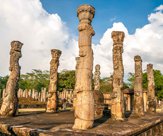Maha Shivarathri or Padmarajarathri means the great night of Shiva or the night of Shiva. As the name implies, it is a night devoted to paying homage to lord Shiva, also known as Mahadeva, who is considered the supreme god by Hindu devotees. Celebrated on the 13th night / 14th day of the Maagha month in the Hindu calendar, it commemorates several legends related to Shiva, demonstrating both his strength and merciful manner.
Devotees flock to Shiva Temples after bathing and purifying themselves at dawn. Clad in clean garments they then carry pots of water to bathe the Shiva Linga in the Temple, after which prayers are offered to Vishnu and Shiva. The sound of bells can be heard from the Temples along with shouts of “Shankerji Ki Jai” (hail Shiva). The Shiva Linga is bathed in water, milk and honey to which woodapple or bhel leave have been added to represent purification of the soul. Thereafter vermillion paste is applied to it, symbolising virtue. Each segment of the pooja is laden with meaning, such as the offering of fruits for longevity and the gratification of desires, burning of incense to yield wealth, lighting of the lamp signifying the attainment of knowledge and the use of betel leaves to represent satisfaction with worldly pleasures.
Devotees fast all day while chanting the sacred Panchakshara mantra dedicated to Shiva “Om Nama Shivaya”, and continue their devotion with a night-long vigil.
Shiva – “The Auspicious One”
Devotees worship Lord Shiva in the aniconic form of Lingam, and his most recognizable image depicts him with a third eye on his forehead, a serpent around his neck, a crescent moon adorning his head and the river Ganga flowing from his matted tresses. His weapon is known as the Trishula and his instrument the Damaru. He is depicted in many forms, one of which is as an omniscient Yogi, another is as part of a family with wife Parvati and sons Ganesha and Kartikeya, and the highest form of Shiva is thought to be limitless, transcendent, unchanging and formless.
The legends of Mahashivarathri
One of the most important legends of Mahashivarathri is the one of Shiva’s second marriage to Parvati. His divine consort Sati or Shakti lost her life when she immolated herself in a Yagna fire. Thereafter Lord Shiva lived the life of an ascetic in the Himalayas. Shakti, now reborn in the family of lord Himalaya as Parvati strove to win back Lord Shiva and finally succeeded. Their marriage was solemnized the day before Amavasya in the month of Phalgun, and this great occasion is commemorated on Mahasivarathri.
Another practice that can be seen during the Mahashivarathri celebrations is the all-night vigil, and this too has a legend attached to it. According to mythology a pot of extremely toxic poison emerged from the depths of the ocean threatening to wipe out all of creation. Lord Shiva was the only one able to swallow it and withstand the effect. Out of compassion for all living beings Mahadeva drank the poison but retained it in his throat, thus preventing it from reaching his stomach. He remained in this manner throughout the night, with the other deities keeping vigil by him playing music and dancing in order to help him stay awake. Creation was saved but the poison was so potent that it turned Lord Shiva’s throat blue, earning him the name Neelakantha (the blue-necked one), ‘Neela’ meaning blue and ‘Kantha’ meaning neck / throat. For Lord Shiva’s sacrifice present day Hindus fast and keep vigil all night singing his praises.
The Lingam is considered one of the most powerful emblems in Hinduism. This was proven in the legend of Shiva Linga or Lingodbhavamurthy, where Vishnu and Brahma engaged in a vain search for the Aadi (beginning) and Antha (end) of Lord Shiva. It is said that disguised as a swan and a boar, they extended their search for thousands of miles in every direction, but were unable to find a limit to the power of the Lingam. Thus they were forced to acknowledge Lord Shiva as the supreme lord.
Among the many such legends that give Mahashivarathri its significance is another very interesting tale of a tribal man named Lubdhaka who was a devotee of Lord Shiva. Losing his way in the deep forest one evening, he climbed a bhel tree to wait out the night. As he was afraid of dozing off and falling from the tree, he kept himself awake by plucking a leaf from the tree and dropping it to the ground while chanting the Lord Shiva’s name at regular intervals. At daybreak he discovered that he had inadvertently worshipped Shiva through the night because he had been dropping the bhel leaves on to a Shiva Lingamat the foot of the tree which he had not noticed in the dark. Lord Shiva was pleased with this and kept away the wild animals, so that the man was safe.
This tale is recited on Mahashivarathri night and is the reason for the offering of bhel leaves to Lord Shiva at this ceremony.
Many other legends have emerged through the ages, every tale adding more intensity to the devotion with which Hindus worship Lord Shiva.
A tour of Shiva Temples
For the devoted worshipper of lord Shiva, Sri Lanka has many Shiva Temples which contain beautiful examples of sculpture and art, while providing a peaceful setting for homage to this greatly revered deity. We can tailor a tour to visit some or all the major Shiva Temples in Sri Lanka. Tours may include visits to Shiva Temples located around the island, the five main shrines being Naguleswaram in the north (may require prior approval), Ketheeswaram in the northwest, Koneswaram in the east, Muneswaram in the west and Tondeswaram in the south, for a memorable and spiritual pilgrimage.






